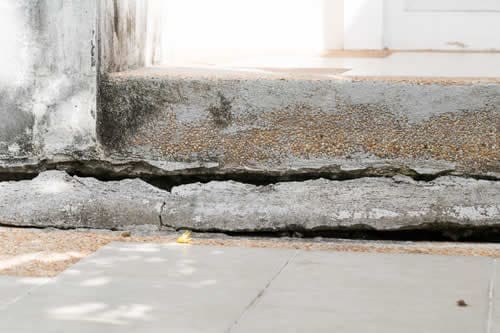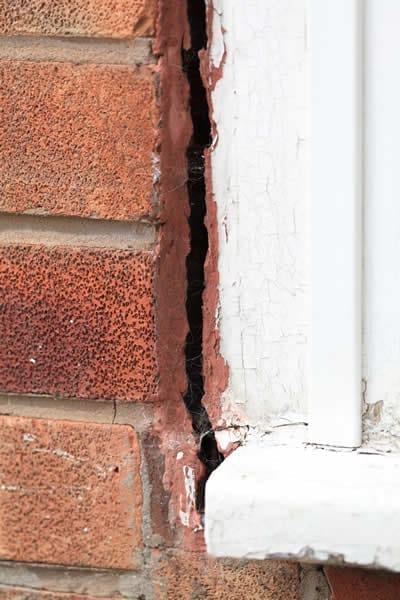At Insurance Claim Solutions, we understand that dealing with insurance claims can often be a daunting process. That’s where we step in as Dublin’s leading loss assessor, offering you comprehensive support and guidance at every stage of your claim.
Subsidence damage as defined by your insurance policy can be hard to prove. Not all cracks in walls and plasterwork mean you have a subsidence problem; many cracks are caused by natural movement in the house structure due to seasonal temperature and moisture level changes.
These tiny cracks are often in a corner where a stud wall joins a block wall, or where a wall joins the ceiling. They are generally insignificant, but diagonal or vertical cracks in walls, especially when they are wider than the thickness of a €1 coin are something to be concerned about.
Most household insurance policies – and some commercial property insurance policies – cover loss or damage caused by subsidence, heave and landslip. Therefore it is best to have them assessed and repaired before the problem gets any bigger.


As several factors can cause subsidence damage, the most disputed area in subsidence claims is “curing the cause” rather than repairing the damage already done.
If a broken drain or badly culverted stream is washing the soil away from under your home, just filling the cracks, replacing twisted door frames is just kicking the can down the road. Around 20% of claims have a curable cause, but without a proper investigation it might not be discovered.
Many new houses develop cracks, especially those built on the ground with high clay content. When soil dries out, it shrinks slightly causing cracks in the plaster and sometimes in the brickwork. The cracks do not always close after it rains, and over a period, sometimes years, they widen considerably.
This kind of subsidence can be compounded by the close proximity of moisture hungry trees and shrubs. As a rule of thumb, do not plant trees any closer to the property than the maximum height the tree could reach.
Another related problem occurs when large trees close to a property are cut down or pruned severely. The moisture this vegetation used to draw away from the building causes the soil to swell up and “foundation heave” can be the result.
Understanding what constitutes subsidence damage under your property insurance policy is crucial for maximising your insurance claim payout. Subsidence coverage is often subject to specific policy conditions, exclusions, and excess amounts that differ significantly from standard property damage coverage. Our experienced public loss assessor team helps identify and document all forms of subsidence damage while navigating complex policy terms and coverage limitations.
Our insurance loss assessor team helps identify and document various categories of subsidence damage that property owners commonly overlook:
Foundation and Structural Damage: The most serious category of subsidence damage involves movement of building foundations, load-bearing walls, and structural supports. This damage can compromise the safety and stability of your entire property and often requires underpinning, structural reinforcement, or complete reconstruction of affected areas.
Clay Soil Subsidence: Dublin’s clay soil conditions are particularly susceptible to subsidence during dry periods when clay shrinks and during wet periods when clay expands. This cyclic movement can cause ongoing structural damage that requires specialised soil stabilisation and foundation protection measures.
Tree Root Subsidence: Large trees near buildings can cause subsidence by extracting moisture from clay soils, causing ground shrinkage and differential settlement. Tree-related subsidence often requires both tree management and structural repair, with ongoing monitoring to prevent recurrence.
Drainage-Related Subsidence: Leaking drains, water mains, or other underground utilities can cause soil erosion and ground instability leading to subsidence. These incidents often involve coordination with utility companies and require both drainage repairs and structural restoration.
Mining and Excavation Subsidence: Historical mining activity or nearby excavation work can cause delayed subsidence effects that may not become apparent for years after the original activity. These claims often involve complex liability issues and require specialised geological investigation.
Natural Ground Movement: Geological factors including soil composition changes, groundwater variations, and natural settling can cause subsidence that requires detailed investigation to determine coverage under insurance policies.
Wall and Ceiling Cracking: Progressive cracking in internal and external walls, ceiling joints, and architectural features often indicates underlying subsidence that requires immediate attention to prevent further deterioration.
Floor and Foundation Settlement: Uneven floors, cracked floor slabs, and foundation movement are common indicators of subsidence that can affect the entire building structure and require comprehensive assessment and repair.

Subsidence damage claims are among the most technically demanding and expensive insurance claims in the property sector. Unlike other types of property damage that affect surface elements, subsidence involves ground movement that can compromise the fundamental structural integrity of your entire property. The gradual nature of subsidence means that damage often develops slowly over months or years, making it difficult to identify the exact cause, timing, and extent of damage without specialised expertise.
When subsidence affects your property, the visible cracks in walls, ceilings, and foundations often represent only a fraction of the total structural damage. Ground movement can affect multiple building elements simultaneously, creating stress concentrations, differential settlement, and progressive deterioration that requires comprehensive structural analysis and potentially extensive reconstruction to ensure long-term stability and safety.

Don’t let the stress of dealing with insurers and repair contractors overwhelm you. Contact us today, and let us handle your insurance claim while you focus on your recovery.
Website Design By Bubblehub Media
WhatsApp us